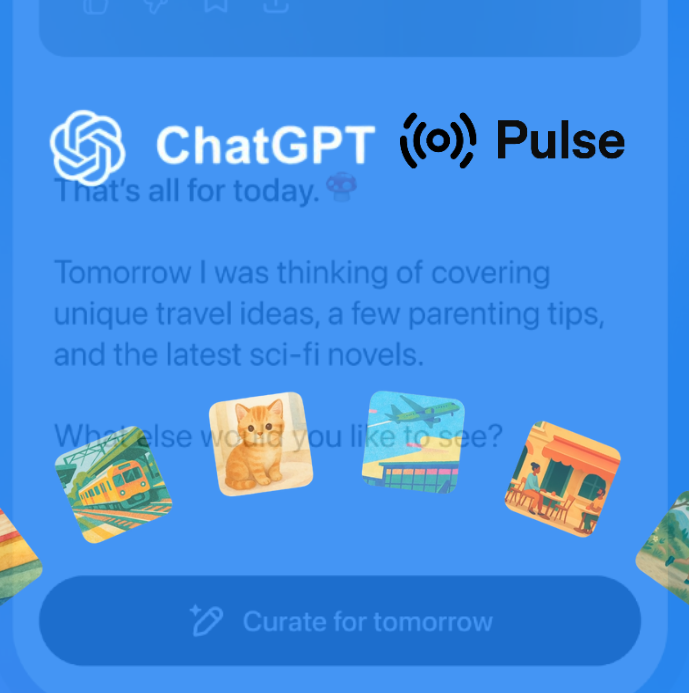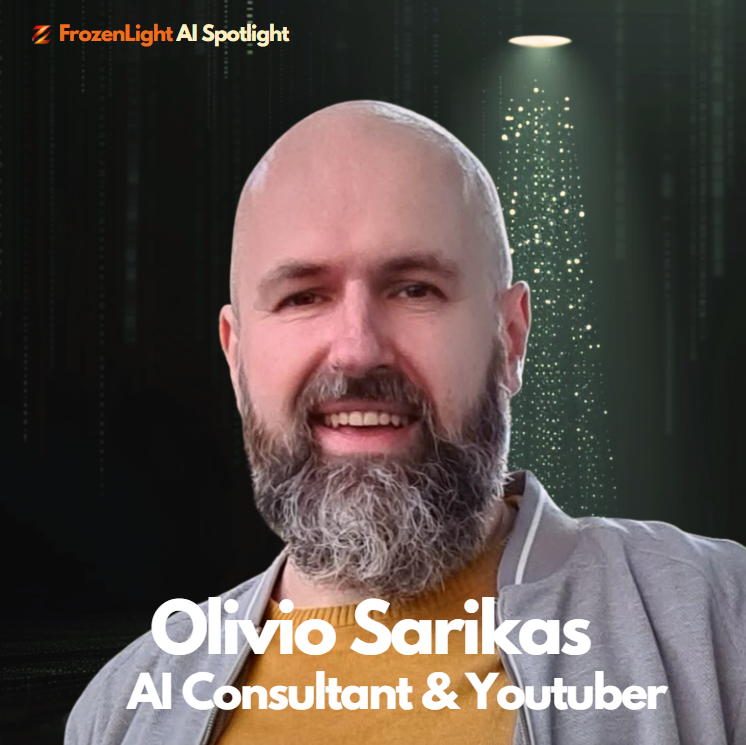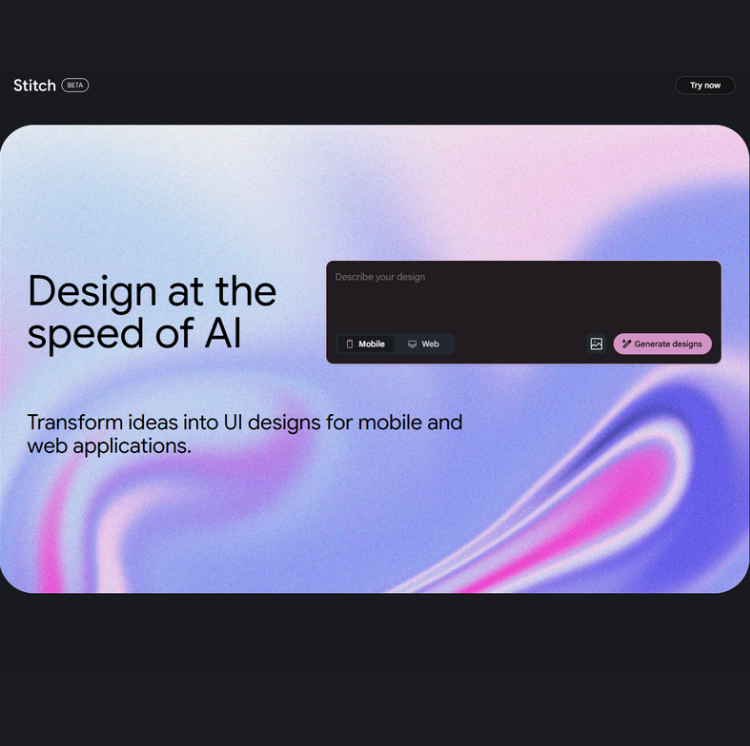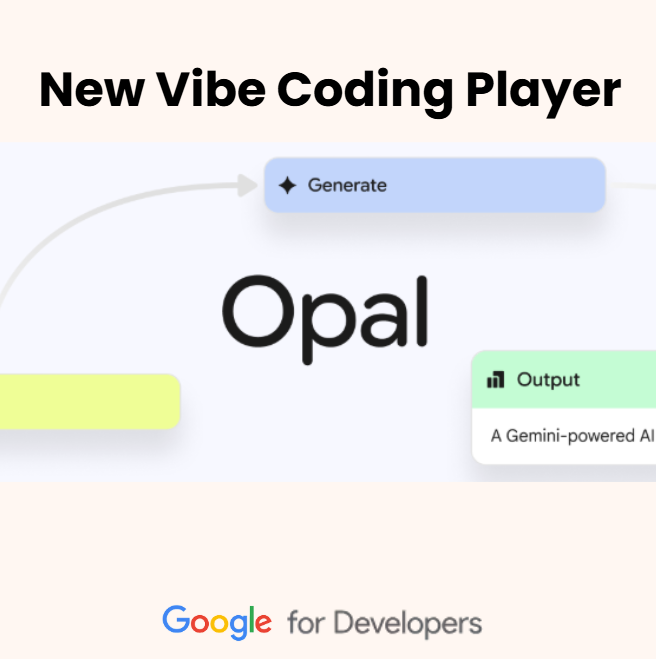
On July 24, Google quietly released Opal in beta - a new experiment from Google Labs that lets anyone build apps with no code.
They’re calling it “vibe coding” - where you just describe what you want, and Opal builds the logic behind it using AI.
The system combines Opal’s new Logic Builder (a visual flow tool) with Google’s existing AppSheet platform (for app design and sharing).
In plain English: you write your idea, Opal wires the backend logic, and AppSheet turns it into a real, usable app.
It’s available now in the U.S. as a public beta - and yes, you can try it.
What Google Is Saying
Google says Opal is designed to help anyone turn ideas into real apps without learning to code.
They frame it as part of their broader push to make app creation more accessible, especially for business users and non-technical teams.
To power that, they’re combining AI-generated logic flows with the trusted interface of AppSheet.
James Maniscalco, Google Labs’ product lead, explained it like this:
“Opal helps you go from a thought to something functional - it’s like building the logic of an app with words.”
What That Means (In Human Words)
Opal is for anyone who wants to build apps without writing code.
You describe what the app should do, and Google’s logic builder turns that into a working app in AppSheet.
It’s useful for:
– HR teams building internal request tools
– Ops managers tracking inventory or workflows
– Finance teams creating approval flows
– Startups prototyping apps fast
– Developers speeding up simple app builds
No drag and drop. No code.
Just logic, written in plain language.
You explain how it should behave. The system builds it.
Opal is now live in beta inside AppSheet.
Let’s Connect the Dots
Wait... didn’t Google already offer something like this?
We’ve heard promises before - “No code!” “Just describe what you want!”
So what’s actually different this time?
Let’s break it down.
How Opal Compares to Google’s Other App-Building Tools
Here’s a clear view of how Opal stacks up against Google’s existing app and code tools:
|
Tool |
Use Case |
Input Style |
Code Required |
Key Feature |
|
AppSheet |
Build custom business apps |
Drag and drop + logic |
❌ |
Great for simple workflow apps |
|
Opal |
Build apps using natural language logic |
Plain text logic |
❌ |
Logic-first design, no UI building needed |
|
Firebase |
Build mobile/web apps with backend |
Code (JS, etc.) |
✅ |
Full-stack development platform |
|
Android Studio |
Build Android apps |
Code (Java/Kotlin) |
✅ |
Best for advanced native Android apps |
|
Vertex AI Search + Gen App Builder |
AI-powered search and app creation |
Prompt-based + config panels |
❌ |
Good for chatbots and internal data apps |
How Opal Compares to Other Vibe Coding Options? Opal vs Base44 and Lovable
If “vibe coding” means describing what you want and watching it take shape -
then Opal isn’t alone in the game.
But the differences matter:
|
Tool |
Who It’s For |
Input Style |
Output Scope |
Standout Feature |
|
Opal |
Internal teams & business builders |
Natural language logic |
Backend app logic (no UI) |
Built on Google infrastructure |
|
Base44 |
Startups & junior devs |
Prompt + visual flow |
Full-stack apps (UI + backend) |
Code-first with no-code-like flexibility |
|
Lovable |
Non-tech creators & solopreneurs |
Text + drag & drop |
Fully designed AI apps |
App templates built from conversations |
What’s the Advantage of Being Built on Google’s Infrastructure?
Let’s be real - it’s Google. That comes with a few practical perks:
|
Google Advantage |
What That Means for You |
|
Security & Compliance |
You get enterprise-level data protection out of the box. |
|
Access to Google Services |
Seamless tie-ins with Sheets, Drive, Gmail, Maps, Vertex AI, and more. |
|
Scalability |
Your app grows automatically without worrying about servers. |
|
Familiar User Tools |
Auth, sharing, admin settings - same logic as the rest of Google Workspace. |
|
Global Reliability |
Your logic runs on the same infra as Google Search and Gmail. |
Bottom Line
📅 Release Date: July 24, 2025 (Beta)
🧠 Tools Launched:
-
Opal (Google’s natural language logic design tool)
-
Logic Builder (no-code backend builder, integrated into AppSheet)
💼 Availability:
-
Included in AppSheet Core, AppSheet Enterprise, and Google Workspace Enterprise plans
-
Already accessible in Beta for eligible accounts
💰 Pricing:
-
AppSheet Core: $5/user/month
-
AppSheet Enterprise: Custom pricing
-
Workspace Enterprise plans include AppSheet access
🌐 Where to Access:
-
AppSheet Editor → https://www.appsheet.com
-
Official Blog → https://developers.googleblog.com/en/introducing-opal
Prompt It Up: Build with Opal - and Let AI Do the Heavy Lifting
Here’s a prompt that will work best with Gemini’s Task Assistant (Pro plan, tools on) -
because of the native Google integration, and because if you like the result,
you’ll actually be able to build it in Opal.
It will also work in ChatGPT or Claude, since both can simulate the kind of logic-based design Opal offers.
🧊 Just copy, paste, and fill in what you want the app to do:
"You are a Gemini Logic Builder expert. Using Google Opal, I want to create an app that does the following: [xxxx].
Please return a complete spec that includes logic flow, UI suggestions, and example phrasing for key actions. Make it detailed and executable."
Want to push it further?
Add this too:
“Now compare this to building the same app in Lovable or Base44.
Tell me what I’d gain or lose in terms of flexibility, effort, and time to launch.”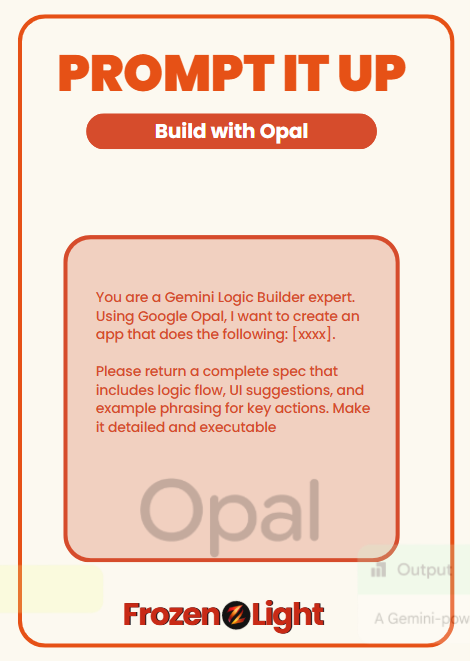
💡 The result you’ll get is a full spec - with clear examples and words showing what to do and how it will look.
From here, it really depends on how mature your idea and vision are.
If you don’t have that, it’ll be hard to take it further or understand what the document is really showing you.
Frozen Light Team Perspective
This isn’t just news about a tool.
This is Google stepping into a fast-growing market - and doing it in a way that shows they’re thinking long-term.
Vibe coding is a trend.
One that’s gathering fans and adopters really quickly 🙂
And if you’ve been watching Lovable and Base44, you already know how fast this space is moving.
Lovable shared they hit $100M ARR in less than a year.
If you do a quick estimate using their pricing (around $69/month), we guess that means over 120K paying users - that’s a huge signal.
Base44?
We don’t know their exact numbers, but based on their investment and momentum, we’re guessing they’ve passed 10K paying users.
(And hey - if someone at Base44 is smiling right now thinking “we’re way bigger” - you probably are 😉)
So what does Google want?
They want those users.
They want the developers, the product teams, the builders of the next wave of apps - who also want it easier, faster, and all in one place.
More than 3 million developers already use Google tools for code.
Now, with Opal, Google is making it easier to build, automate, and grow - all inside their ecosystem.
And for us?
It brings up a question:
Do we really need to pay for three separate tools to build, automate, and ship apps?
Or can we just stay inside one platform - like Google - that already knows how to scale?
The answer depends on your needs -
and how well Google delivers compared to Lovable and Base44.
But here’s what caught our eye:
Opal is still in beta.
Google even calls it an experimental tool.
To us, that says something:
They’re not claiming it’s fully baked.
They’re moving fast, testing publicly, and building in the open.
That’s a real commitment to competing - not just releasing and walking away.
One last thing we really liked:
Google made a point to highlight the power of the community.
Even in 2025, the idea of sharing what we build - and learning from each other - is still alive.
We loved seeing that.
Because no matter how smart AI gets, human connection is still a thing.





